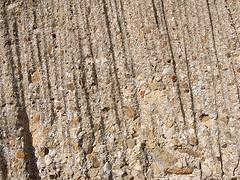 In the presence of K + and a +, this process is enhanced, since the carbon dioxide in access of air to the evaporating surface of the concrete is carbonated alkali, with formation and 1a2SOZ K2SOZ. In addition to salt concrete surface is subject to the effect of alternate thawing and zamorazhivashiya, as well as drying and wetting. In the zone of variable water levels, due to obschesolevoy lack of corrosion, broken concrete, to a lesser extent than the water, but in the immediate vicinity of the upper level. The underwater part of the concrete, not the action of these Recycle factors are rarely destroyed. The combined effect of M2 + and HCO-leads to the formation of an underwater concrete outer cover, usually consisting of a layer of brucite thickness of about 30 microns, which is superimposed on a slowly formed layer of aragonite. CCO precipitated primarily as aragonite, rather than as calcite, due to the presence of M2 + ions. In the case of a good quality of the concrete layer that provides a corresponding weakening of Uzziah . To the extent that it is still occurs, aggression involves leaching processes, the impact of M $ O4, carbon corrosion, penetration of the C1-ions, and the possible corrosion of reinforcement.
In the presence of K + and a +, this process is enhanced, since the carbon dioxide in access of air to the evaporating surface of the concrete is carbonated alkali, with formation and 1a2SOZ K2SOZ. In addition to salt concrete surface is subject to the effect of alternate thawing and zamorazhivashiya, as well as drying and wetting. In the zone of variable water levels, due to obschesolevoy lack of corrosion, broken concrete, to a lesser extent than the water, but in the immediate vicinity of the upper level. The underwater part of the concrete, not the action of these Recycle factors are rarely destroyed. The combined effect of M2 + and HCO-leads to the formation of an underwater concrete outer cover, usually consisting of a layer of brucite thickness of about 30 microns, which is superimposed on a slowly formed layer of aragonite. CCO precipitated primarily as aragonite, rather than as calcite, due to the presence of M2 + ions. In the case of a good quality of the concrete layer that provides a corresponding weakening of Uzziah . To the extent that it is still occurs, aggression involves leaching processes, the impact of M $ O4, carbon corrosion, penetration of the C1-ions, and the possible corrosion of reinforcement.
Corrosion of steel reinforcement of concrete in sea water is observed only in the presence of dense, impermeable protective layer of considerable thickness, more than 4.5 cm are particularly serious and dangerous for the construction of the whole damage of thin concrete elements, such as piles. The possibility of manufacturing durable piles for offshore structures lies in the application of FRP reinforcement surface. Such construction for corrosion resistance and frost are not inferior construction made entirely of polymeric materials, and for strength, rigidity and stability of their superior. Durability of structures with external glass fiber reinforcement is determined by the corrosion resistance of the latter.